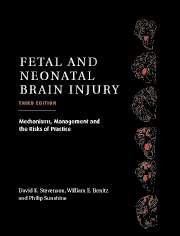Book contents
- Frontmatter
- Contents
- List of contributors
- Foreword
- Preface
- Part I Epidemiology, Pathophysiology, and Pathogenesis of Fetal and Neonatal Brain Injury
- Part II Pregnancy, Labor, and Delivery Complications Causing Brain Injury
- 9 Maternal diseases that affect fetal development
- 10 Antepartum evaluation of fetal well-being
- 11 Intrapartum evaluation of the fetus
- 12 Obstetrical conditions and practices that affect the fetus and newborn
- 13 Fetal and neonatal injury as a consequence of maternal substance abuse
- 14 Chorioamnionitis and its possible relation to subsequent cerebral palsy
- 15 Bacterial sepsis in the neonate
- 16 Neonatal bacterial meningitis
- 17 Neurological sequelae of congenital perinatal infection
- 18 Perinatal human immunodeficiency virus infection
- 19 Inborn errors of metabolism with features of hypoxic–ischemic encephalopathy
- Part III Diagnosis of the Infant with Asphyxia
- Part IV Specific Conditions Associated with Fetal and Neonatal Brain Injury
- Part V Management of the Depressed or Neurologically Dysfunctional Neonate
- Part VI Assessing the Outcome of the Asphyxiated Infant
- Index
- Plate section
11 - Intrapartum evaluation of the fetus
from Part II - Pregnancy, Labor, and Delivery Complications Causing Brain Injury
Published online by Cambridge University Press: 10 November 2010
- Frontmatter
- Contents
- List of contributors
- Foreword
- Preface
- Part I Epidemiology, Pathophysiology, and Pathogenesis of Fetal and Neonatal Brain Injury
- Part II Pregnancy, Labor, and Delivery Complications Causing Brain Injury
- 9 Maternal diseases that affect fetal development
- 10 Antepartum evaluation of fetal well-being
- 11 Intrapartum evaluation of the fetus
- 12 Obstetrical conditions and practices that affect the fetus and newborn
- 13 Fetal and neonatal injury as a consequence of maternal substance abuse
- 14 Chorioamnionitis and its possible relation to subsequent cerebral palsy
- 15 Bacterial sepsis in the neonate
- 16 Neonatal bacterial meningitis
- 17 Neurological sequelae of congenital perinatal infection
- 18 Perinatal human immunodeficiency virus infection
- 19 Inborn errors of metabolism with features of hypoxic–ischemic encephalopathy
- Part III Diagnosis of the Infant with Asphyxia
- Part IV Specific Conditions Associated with Fetal and Neonatal Brain Injury
- Part V Management of the Depressed or Neurologically Dysfunctional Neonate
- Part VI Assessing the Outcome of the Asphyxiated Infant
- Index
- Plate section
Summary
Introduction
Fetal heart rate (FHR) monitoring during labor was introduced into clinical practice in the 1970s. At the time, obstetric providers and researchers in fetal physiology believed electronic fetal monitoring (EFM) would identify changes in the FHR and/or rhythm that reflect fetal acidosis. Second, it was presumed that detection would be early enough to allow clinical intervention that would prevent perinatal asphyxia. Despite 20 years of widespread use and multiple randomized clinical trials, FHR monitoring has not been shown to decrease perinatal mortality. The relationship between intrapartum FHR monitoring and fetal acidosis is complex. Both of the suppositions stated above were problematic. This chapter reviews the physiology underlying FHR patterns, the reasons why randomized trials of EFM have failed to demonstrate efficacy, and the current knowledge that guides interpretation of EFM in the intrapartum period.
The history of EFM
The discovery of fetal heart tones in 1821 marked the beginning of modern obstetric practice. Jean Alexandre Lejumeau, Vicomte de Kergaradec, correctly identified the FHR when using a stethoscope, hoping to hear the noise of the water in the uterus. FHR detection was rapidly used to improve obstetrical care. The ability to determine life or death of the fetus supported the decision to do a postmortem cesarean section (albeit a rare occurrence), helped determine fetal position, diagnosed multiple pregnancies, and quickly became the definitive positive sign of pregnancy.
- Type
- Chapter
- Information
- Fetal and Neonatal Brain InjuryMechanisms, Management and the Risks of Practice, pp. 226 - 243Publisher: Cambridge University PressPrint publication year: 2003
- 2
- Cited by



